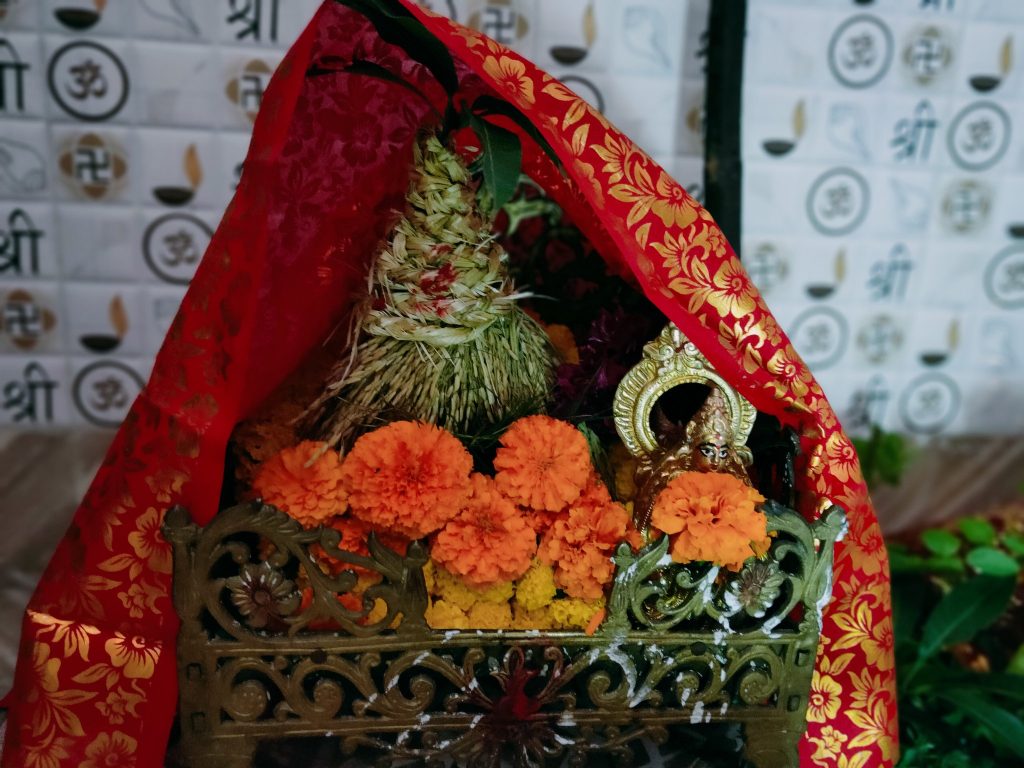During the wintery months of November and December, the households of Odisha gear up to welcome goddess Lakshmi. Goddess Lakshmi is worshipped with sincere devotion during Margasira month on every Gurubaras (Thursdays). This ritual is known as Manabasa Gurubar.
The customary ritual derives its name from mana; an ancient measuring device used in ancient times all across the state. The mana has ancient lineage with cultivation and harvesting of crops which were once the main occupation of the people of the state.

Ritual of the Farmer Community
The farmer community who had been working tirelessly for the past several months to fill their reeks and barns with freshly harvested paddy. The farmers believe the harvest as the grace and blessing of goddess Lakshmi. They worship the paddy filled mana as the symbol of Goddess Manabasa Gurubar .
It is also believed that the goddess Lakhsmi visits the houses of her devotees on all Gurubaras of the month. Customs believe that this is to acknowledge how she is worshipped Manabasa Gurubar as well as bestow her blessings on the households.
You can read our another post on The Leaning Temple of Huma: A Unique Architectural Wonder
The Customary Practices
The ladies of the household clean the house and decorate the walls and floors with artistic chitasand jhotisin rice paste on the eve of every Thursday. The next morning, they get up early in the morning, have purification bath. The ladies adorn alata(red dye) on their feet and sindura (vermilion) on their foreheads. In many houses, the married women folk wear new saris. As customary the ladies keepupabasha(fast) for the sake and well-being of the family members. As day progresses, they worship goddess Lakshmi and break theupabasha.
The entire process is more discrete on the last Thursday of the month. The entire house is dusted and cleaned. The walls and floors are mopped in cow dung solution in most of the rural houses, whereas cow dung solution is sprinkled in the pucca cement houses as it is believed that cow dung solution sanctifies the entire house and wards off evil energy. Numerous designs of chittasand jhotis Manabasa Gurubar are drawn on the floors and walls.
A corner of the entrance door is decorated with a pair of banana sapling and a pair of kalasha is placed beneath its trunk. The saplings are considered auspicious and are found relevant in every Hindu religious function. In addition to this, miniature foot marks from the entrance door to the Manabasa Gurubar room for worship are drawn on the floor; which symbolise the route to welcome the goddess inside the house.
Puja Setup
Two manas(a large and a small) decorated with jhotisare heaped above the brim with freshly harvested dhana(paddy) and muga (green gram) respectively. A pair of red bangles, three betel nuts washed in turmeric water, vermilion and flower garlands are the necessary items for the puja. The entire setup is placed on them which are then kept on a pidha over the central jhoti and is covered with a red pious cloth. A Dhana menta is hung over the manas, but in some cases it is placed by their side. The idol of goddess Lakshmi is placed by the side of manas.
As the worship continues, the manas representing the goddess are worshiped with panchaupachara (dipa, dhupa, argha, pusphaandnaibedya). Many a number of pithas(homemade cakes), khiri (sweet puddings) and seasonal fruits are offered as naibedya to the idol of Goddess Lakhsmi.
The ladies then recite Mahlakshmi purana (penned by ancient poet saint Balaram Das) or Manabasa gurubara katha describing the story of lord Jagannatha and how Lord Jagannatha faced many difficulties when he discarded Lakshmi after she entered the house of a chandaluni Shreya to accept her worship. The entire family sits together to listen to the katha. The ritual then concludes and the upabashais broken.
The worshippers keep awake the whole night to welcome and worship her as it is believed that the goddess visits the houses of her worshippers during the night. The ladies spend the night reciting Lakshmi purana and other scriptures and is known as Kojagari puja.
More: Wanted to download Odishashop.com visit here
Conclusionn
Manabasa Gurubar or Mahalaxmi Puja as the world knows it is a celebration of prosperity, specially for farmers who have started harvesting paddy. It is a tradition embedded with the spirit of thankfulness to the Goddess Laxmi for bringing prosperity to the house and the family.

